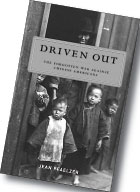On the weekend of Feburary 6, 1885, scores of Chinese were expelled from Eureka, a small town of Humboldt in northwest California. They were put on two steamships bound for San Francisco. When they arrived on Monday, a group of 52, under the leadership of a man named Wing Hing, announced a joint lawsuit against the town.
They sought reparations for property damage, for their struggle to obtain land, and other claims such as the right for their children to enter the public education system.
This was the first collective lawsuit filed by Chinese in the United States.
"This (lawsuit) also protected several thousand other Chinese, forcing other towns which wanted to do the same thing to think twice," says Jean Pfealzer, a history professor of the University of Delaware.
Pfealzer has just published a new book: Driven Out: The Forgotten Wars Against Chinese Americans, which reveals a chapter of history that has been largely forgotten.
From 1849 to 1906, violent incidents against Chinese occurred in about 250 cities and towns across California and the Northwest and the Mid-west of the United States. Many thousands of Chinese Americans were forced out of their homes, some were deported and some were even beaten to death.
Professor Pfealzer, who spent over seven years preparing for the book, has been studying Chinese Americans for more than 30 years.
In the 1970s, Pfealzer landed a teaching job at the California State University in Humboldt. There were no Chinese students in her class.
"I was born in Los Angeles and I thought 'this is not how it should be here'," she says.
When she asked about the absence of Chinese faces, a woman told her that Chinese families wouldn't send their kids here, because 100 years ago, they were driven out.
This piqued Pfealzer's interest in finding out more about her beloved Humboldt. "The more you love it, the more you desire to look into its history," she says.
In the library of the University of California Berkeley, Pfealzer looked for 19th century newspapers and microfilms. "I discovered that this was not a story about one town, but 250 towns," she says.
Even though Pfealzer was shocked by what she regards as "ethnic cleansing", she was even more moved by the indomitable Chinese spirit.
"They fought back with everything. They were so courageous," she says.
After the Californian gold rush began in 1849, Chinese immigrants started to arrive the following year. As more and more made the journey across, violent acts against Chinese became a regular occurrence.
In protest, Chinese organized strikes, refused to sell vegetables and brought arms from home. In 1893, more than 100,000 Chinese refused to wear their photo ID, as required by American law.
"My book is not merely about this shameful history, it is also about pride and courage," Pfealzer emphasizes.
"I think Chinese won this war, because they stayed. They even returned to Eureka, they never left Los Angeles, they did not move out of San Jose even though the Chinatown there was burnt down five times."
Pfealzer also recited the story of Yoke Leen, a 36-year-old woman, who was bought and sold many times to be a prostitute. She was the first Chinese woman to front an American court to claim her rights. "I am a free person, my husband is in jail, but I have come here to say, no man will ever own me again, " Yoke said during her address.
In November 2004, Pfealzer studied briefly at the International Study University in Xi'an of Northwest China's Shaanxi Province. There, she couldn't find anyone who knew about this period of history, nor could she find much relevant material for her book. Pfealzer hopes her latest work is helpful for Chinese to understand the history of Chinese Americans.
Pfealzer says Chinese Americans have made great contributions to the United States. They paved railroads, assisted in the development of agriculture, and constructed Chinatowns.
They were also involved in political organizations, and helped shape legislation. Over 80 years ago, the breakthrough case of "Tape vs Hurley", saw the parents of Mamye Tape, a half white, half Chinese girl, sue the San Francisco Board of Education and push for public schools to accept Chinese children.
Last year, the Canadian government apologized for the "exclusion act", does the American government need to do the same thing? Pfealzer says that an oral apology isn't as important as bridging the gap between the races.
"The apology is complicated. For some, it is the first step but for others, the apology is a quick 'sorry, let's move on'. For instance, this year, Maryland and Virginia states apologized for slavery, but have the lives of African Americans children really changed?"
In the town of Tacoma, Washington, a Chinese community plans to use four acres of waterfront land to build a park called "The Chinese American Reconciliation Park". There, details about the expulsion from 100 years ago will be on display.
(China Daily November 12, 2007)


